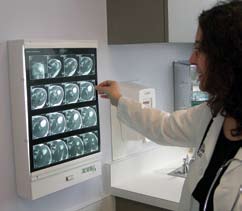How do Rehabilitation Physicians Diagnose?
 Dr. Aull examines each ailment without haste so she can accurately zero in on the main causes. She uses a combination of special electrodiagnostic medicine techniques along with the usual tools that other physicians use in order to perform an accurate diagnosis. The common tools she uses include physical examinations, medical histories, x-rays, MRI scans, CT scans, and PET scans; and the special techniques used include nerve conduction studies, somatosensory evoked potentials, and electromyography (EMG). Using these techniques, Dr. Aull diagnoses conditions causing dysfunction, numbness, and weakness.
Dr. Aull examines each ailment without haste so she can accurately zero in on the main causes. She uses a combination of special electrodiagnostic medicine techniques along with the usual tools that other physicians use in order to perform an accurate diagnosis. The common tools she uses include physical examinations, medical histories, x-rays, MRI scans, CT scans, and PET scans; and the special techniques used include nerve conduction studies, somatosensory evoked potentials, and electromyography (EMG). Using these techniques, Dr. Aull diagnoses conditions causing dysfunction, numbness, and weakness.
Diagnostic Tools
EMG (Electromyography): Helps in the measurement of muscle response and the evaluation of electrical activity within a set of muscle fibers. This test is useful when trying to understand whether it’s a muscle disorder or a nerve disorder.
Nerve Conduction Studies: These help evaluate the speed with which nerve impulses travel, which helps understand whether a nerve has been damaged or destroyed. In case it is damaged, this test also helps understand the extent of the damage. This is usually carried out along with EMG.
Sometimes, it helps the doctor in the diagnosis of your condition if he is aware of any abnormalities in the electrical activity in a particular muscle or nerve.
EMG may help diagnose a number of common conditions such as nerve root injury (e.g. sciatica), nerve injury or compression (e.g. carpal tunnel syndrome), and some other problems with the nerves or muscles. It may also help diagnose certain less common conditions such as amyotrophic lateral sclerosis, muscular dystrophy, and myasthenia gravis.
Somatosensory Evoked Potentials (SSEPS): Helps in testing the pathways present between those peripheral nerves that run through the spinal cord all the way to the brain
